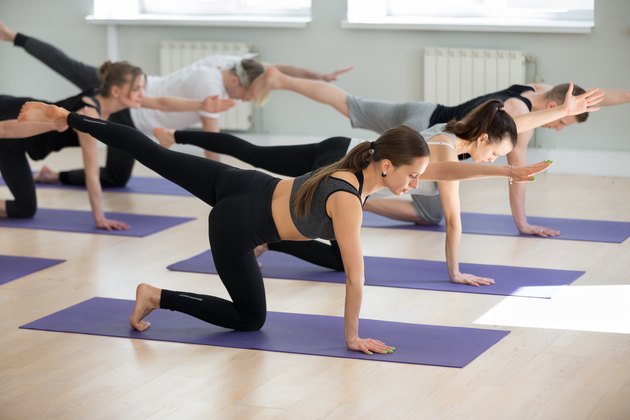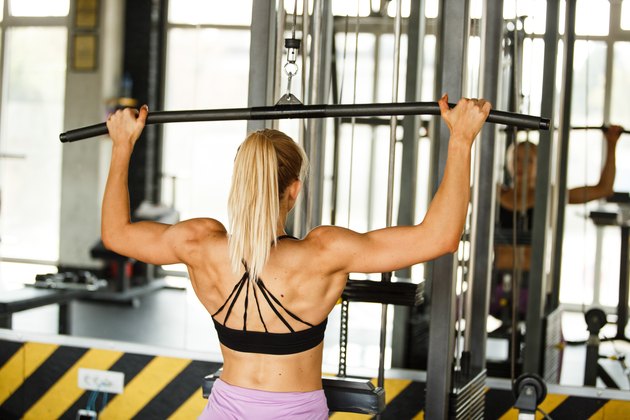If you find yourself slouching constantly, jutting your neck forward or feel like you're wearing your shoulder blades as a necklace, you might have a condition known as postural kyphosis. Happily, postural kyphosis treatment often involves exercises you can do at home.

Video of the Day
What Is Kyphosis?
If your mother ever told you that if you kept slouching you might get stuck that way, well — she was right, to a point. The everyday choices you make about posture and body position, even things as simple as how you sit or stand, have a very real impact on postural kyphosis.
The key to understanding this condition is in its name: The natural curve in your thoracic spine — the section between your lower back and your neck — is called kyphosis. If that curve becomes exaggerated by bad posture, as opposed to traumatic injury or a medical condition, it's dubbed postural kyphosis.
The good news: If the condition is caused by bad posture it can be treated, or at least helped along, by encouraging habits that contribute to good posture. That's not just about standing up straight — the American Academy of Orthopaedic Surgeons lists common symptoms of kyphosis that can include forward-rounded shoulders, back pain, fatigue, tight hamstrings and a stiff spine. In rare cases and over time, kyphosis can also progress to symptoms that include numbness or tingling, loss of sensation and difficulty breathing.
Although postural kyphosis can be helped by doing kyphosis exercises at home, it's always best to tackle this sort of thing with the supervision of medical professionals, because they can screen you to be sure nothing else is contributing to your symptoms. They can also zero in on the exercises that are most helpful for your body.
Examples of Kyphosis Exercises
As you'll see, some of these exercises aren't specific to cases of postural kyphosis; you might even have a few of them in your workout program already. But as the University of Maryland Medical Center points out, strengthening the back muscles can help correct postural kyphosis.
It's also helpful to note that in a study published in the March 2018 issue of the Journal of Physical Therapy Science, researchers found that exercises for correcting thoracic posture also improved scapular position.
This was a small study, involving just 10 subjects, each of whom had an extreme kyphosis of greater than 40 degrees — and correlation isn't causation. But it also illustrates how intimately spinal dysfunction and scapular dysfunction are tied together and, in the complex ecosystem of levers and pulleys that is your body, it's impossible to treat one closely connected dysfunction without also addressing the other.
Your physical therapist will tell you how many reps of each exercise you should do — but as a general rule, aim for high repetitions spaced two or three times throughout the day. After all, the goal is to retrain your body's unconscious postural habits into something healthy and functional, not to build yourself into an upright Hulk.
1. I-Y-T Raises
In an April 2018 study published by the American Council on Exercise, researchers evaluated which exercises provoked the most activity in several back muscles — including the lower trapezius. The lower portions of your two fan-shaped trapezius muscles are tasked with bringing your shoulder blades back and down, which is an important part of resuming proper posture. And of the exercises tested, I-Y-T raises generated the most activity in the lower trapezius.
- Lie face-down on a bench and extend your arms straight down to the floor, palms facing in.
- Raise your arms straight overhead so they're in line with your body; this forms the letter "I." Then lower your arms back to the starting position.
- Next, lift your arms out at a 45-degree angle — this is the "Y." Lower your arms back to the floor.
- Finally, turn your palms toward the floor and lift them out at right angles to form the "T." Lowering your arms back to the floor completes one repetition.
2. High Scapular Retraction
A June 2016 systematic review, published in the International Journal of Sports Physical Therapy, analyzed existing studies to identify which exercises produced the optimal ratios of muscular activity in scapular stabilizers. High scapular retraction was among the best for the lower trapezius.
Here's one version of how to do it:
- Stand facing a wall, right next to the wall. Extend your arms up along the wall, keeping them as straight as possible.
- Squeeze your shoulder blades down and together; it might help to imagine that you're squeezing a pencil between them. You can also have a friend put a finger between your shoulder blades and try to squeeze their finger — just make sure you're bringing your shoulder blades down, not up.
- Hold for a count of three, then release and prepare to squeeze again.
3. Prone Back Extensions
This exercise gives you a chance to practice that scapular retraction and depression you've been working on, while also strengthening your erector spinae, muscles, which help extend and stabilize the length of your spine.
- Lie face-down on a yoga mat, towel or other comfortable surface. To start with, keep your arms by your sides. Check to make sure your chin isn't jutting forward — you should be looking down at the floor, not straight ahead.
- Bring your shoulder blades back and down, as you've been practicing, and lift your shoulders a couple inches off the floor. This shouldn't be a huge motion; your abdomen will stay in contact with the floor.
- Hold this position for a slow count of three, then repeat. As you progress, you can increase the hold time and the number of repetitions.
Eventually, you'll be able to do this exercise with your arms extended straight overhead (like Superman flying), which makes the workout much harder.
4. Bent-Over Row
In the aforementioned ACE study, the best "classic gym exercise" for your lower trapezius is the bent-over row. This exercise demands quite a bit of core stability, so it makes a good goal to work toward. The other exercises listed here can help you build the strength and stability to do these rows with proper form.
- Hold a dumbbell in each hand; you can also do this exercise with a barbell.
- Soften your knees and hinge forward from the hips. Get as close to horizontal as you can while still keeping your back flat, chest up and open.
- Maintain this body position as you pull both weights up alongside your body in a rowing motion. Stick to a comfortable range of motion and keep the movement under control; there's no need to punch your elbows through the ceiling.
- Keep your shoulder blades pinched together — think "shoulders back and down to my tailbone" — as you extend your arms to lower the weights. This completes one repetition.
Read more: Best Back Exercises With Dumbbells
Other Elements of Treatment
Strengthening your back is just one aspect of postural kyphosis treatment. Your physical therapist or doctor might also ask you to include assessing how you sit, especially if you work a desk job. Making just a few changes to your work environment and general living habits can do a lot to encourage proper posture again.
Postural kyphosis of the thoracic spine may also be accompanied by tight pectoral muscles and exaggerated lordosis (backward curve) of the lumbar spine. Taking the time to regularly stretch your chest can help with the former, while stretching your hamstrings, hip flexors and lower back can help counteract the bad posture and relieve pressure in your lumbar spine.
